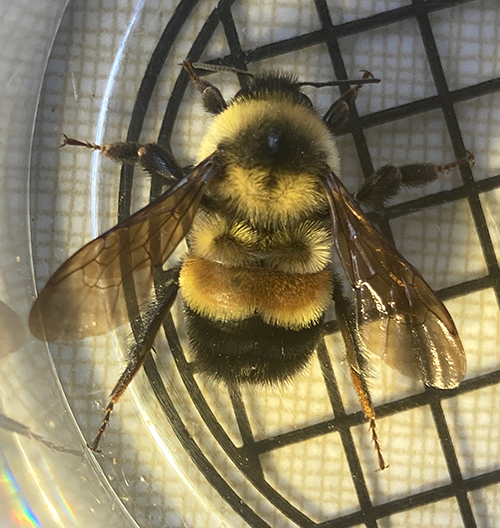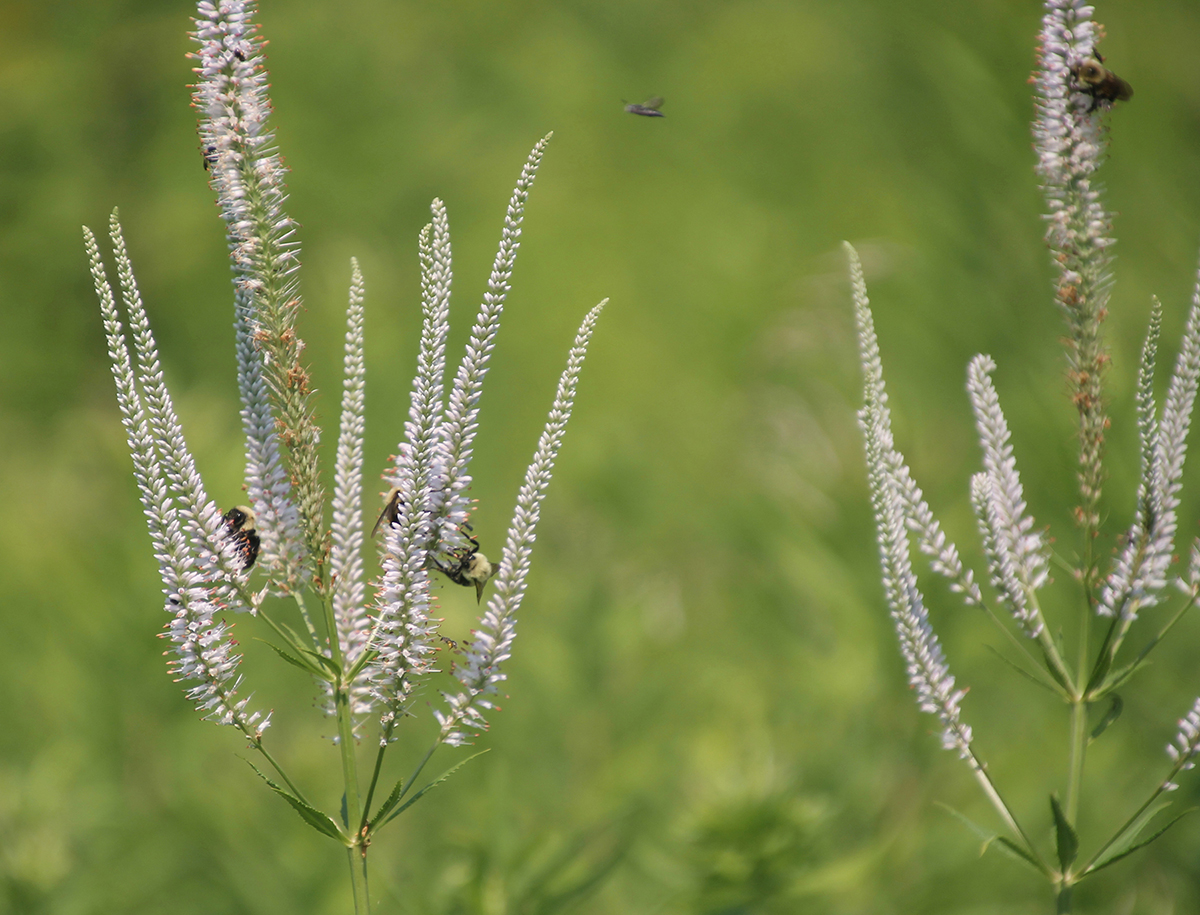
The federally endangered Rusty Patched Bumble Bee observed in a protected habitat in Peoria County. (PHOTO BY MIKE MILLER)

MIKE MILLER
In the eastern United States, there are 21 species of bumble bees. These large, furry, big-bodied bees seem almost comical. Donning various coats of black and yellow stripes, they labor through the air from flower to flower. It is amazing their tiny wings allow them to fly, but it seems to work for them. Learning to identify different species of bumble bees involves close observation of the color patterns on their abdomens and “bare” patches between the wings. There are several guides to identification of the various bumble bees available online. (Some good ones can be found here https://beespotter.org/topics/key/).
You might wonder why anyone would want to identify bumble bees. One reason is that many species are in severe decline, and unless we get a grasp on where the different species are being found, we stand a good chance of losing these beneficial insects forever. Luckily, bumble bees don’t mind close observation. When they are working on collecting pollen to feed their young, or sipping nectar to fuel their flight, they are quite docile. This allows the observer to get quite close to observe their color patterns.
One species of bumble bee has been officially listed as an endangered species under the Endangered Species Act. The Rusty Patched Bumble Bee has seen over a 90% decline in its population in the last 20 years. This bee was once common throughout the eastern United States and Great Lakes region. Our region of Central Illinois is one of the few places it can still be found, and it is consistently observed in our prairies and woodlands. There are other species of bumble bees being considered for endangered species status. If we lose our native bumble bees, it will be devastating for our nation’s food security. Everyone seems to know that honey bees are important pollinators for certain crops, but few people seem to understand that it is the wild, native bumble bee population that actually does the bulk of the food pollination in the United States. It is estimated that pollination services provided by native pollinators calculates out to over $3 billion per year.
The recent decline in populations of native bumble bees likely has several contributing factors. One is loss, or decline, of habitat. As the native landscapes become developed into either agriculture or urban areas, the availability of a season-long supply of flowering plants becomes quite rare. If bees do not have a stable pollen and nectar source, their hives will fail. It takes a diversity of flowers to keep bumble bees healthy. Each species of bumble bee has its own preference as to the species of plants they are attracted to. Some species have long mouth-parts, and can dig deep for nectar. Others have very short mouthparts and need to feed on “shallower” flower species. This jig-saw puzzle of mouthparts and flower-parts has allowed for a diverse group of insects to find their own little niche in the natural world. Food specialization tends to reduce interspecies competition for resources. However, what is a benefit within a diverse prairie ecosystem, becomes a liability when flower diversity is reduced due to development.
Another threat come from increased use of pesticides. Since 1990, the acreage of cropland that has come under intense chemical management has grown exponentially. The effects of this on species of in-sects that are actively flying through areas where pesticides are applied to visit plants and collect pollen is largely unknown.
Finally, global climate change is another factor. Face it, the calendar is no longer a good indicator of what type of weather you might face when you walk out the door; snow in late April, 80-degree days in February. It seems odd to us, but imagine it from the bumble bee’s perspective. When the natural world no longer seems to be following a logical climate pattern, it negatively effects blooming cycles of plants. That can cascade into disastrous circumstances for species tied to a consistent food source.
When you think about it, we aren’t all that different from the bumble bees. We like to think we are beyond the threats of habitat loss, pesticide use, and climate change. In reality, we might be at higher risk given our top perch on the good old food pyramid. Each species that is lost crumbles the base of our livelihood. When common species such as bumble bees become endangered, are we far behind?


1 comment for “Nature Rambles | Bumble Bee Summer”
Recent Comments
If you would like to learn more about the Rusty Patched Bumble Bee, there is a great documentary called “A Ghost in the Making” it can be found at this link:
http://www.rustypatched.com